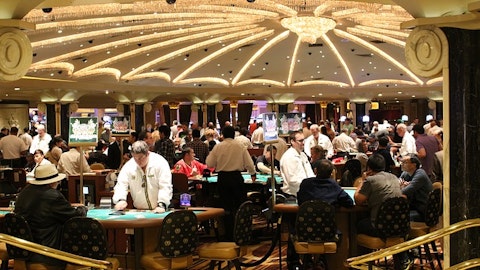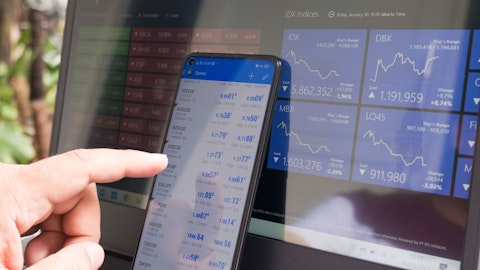John Payne: Yes, Chris, it’s John. As when we made the announcement a few months ago, we talked about spending a couple of years studying the youth sports business and we learned a lot in that process. We’ve also found an amazing partner in Homefield. We announced our first opportunity with them in the Kansas City area and they’re building not only the youth sports facility but connected to a Margaritaville Resorts. That’s one of the things, I think you’ll continue to see is if we place other investments into the youth sports spaces, having numerous cash registers, not just having the fields to rent or the stadiums to rent, but also having connected to one operator who controls the restaurants, who controls the hotel rooms and controls the sports fields.
So, this is a $110 millionish initial investment with Homefield. We’ve not announced any further development not only on that site, which does have opportunity to expand over time, but also other sites around the Midwest or the United States. But as with any partner that we’ve talked about whether that’s with casino partners or with Cabot or Canyon Ranch and now Homefield, we hope that it’s not just our only investment with them and we purposely took so much time to study the business to find the right partner to grow.
Chris Darling: I appreciate the thoughts. Thank you.
Operator: We now turn to Greg McGinniss with Scotiabank. Your line is open. Please go ahead.
Greg McGinniss: Hey. Good morning. So, as you continue to invest in non-gaming assets, how should investors get comfortable with more opaque tenant financials there? And what sort of premium are you receiving from an investment yield standpoint as it compares to a potential gaming investment?
Edward B. Pitoniak: Yes. So, you are right, Greg. If we’re partnering with an experiential operator that’s not public, the tenant financials are not crystal clear in the same way they’re not crystal clear across a whole lot of net lease portfolios. And at the end of the day, we obviously have to exercise our fiduciary responsibility to the greatest degree possible in ensuring that the fundamental business is very, very supportive of the rent and the way in which our operating partners manage their balance sheets and liquidity is also of a strength that ensures that they won’t be in positions where they’re unable to meet the rent. We’ve got a very rigorous underwriting practice. We obviously can take advantage of history in many of the categories, experiential categories that we’re investing in.
And again, at the end of the day, it’s up to us to make sure that they are of a strength, that’s going to enable them to weather whatever should come their way. But I will also emphasize that our key criteria, our first of four criteria in evaluating all investments, gaming and experiential widely, is that the businesses be of lower than average cyclicality versus consumer discretionary at large, which we think is another risk mitigant when it comes to ensuring that they can cover the rent through thick and thin.
Greg McGinniss: Just to follow-up on that, in the cases where you’re providing construction loans, where may there’s not kind of in place cash flows to be underwriting or evaluating. What’s the process look like there when you’re trying to get comfortable, in terms of lending that money and the ability to recollect in the case that, maybe cash flows don’t hit quite the targets that were expected?
Edward B. Pitoniak: Well, last dollar exposure is obviously one of the key criteria and ensuring that our last dollar exposure is at a level whereby if we did end up owning the asset that the operating economics are such that at the last dollar exposure level that we would be lending at, we’re still in good shape.
John Payne: Yes, Greg, and then it comes down, as I mentioned, quality of the sponsors, the amount of equities, the overall loan-to-cost or loan-to-value and then the protections that are obviously ultimately documented in our agreements. But a lot of the sectors and we like our sale leaseback investments, we study the sectors. Indoor water parts, we studied for 18 odd months led by certain members of our team and went deep into that sector before we did anything. And so it’s getting gaining conviction whether it be through direct real estate ownership or the lending platform that we have of who the operator is, the durability of the sector and then the ultimate protections that we can put in place.
Greg McGinniss: Okay, thanks. And just a final one for me. And I’d like to preface this question by acknowledging the great work that John and his team have done so far. We know that you’ve added some great members to the investment team as well. But given your sector low G&A, how do you balance that shareholder friendly expense line versus investing in a larger acquisitions team that could maybe help source and underwrite more investment opportunities?
Edward B. Pitoniak: No, it’s a very fair strategic question, Greg, and it’s a question we regularly wrestle with. I would say one of the ways in which we deal with, if you will, the underinvestment risk in G&A is by, I think, having forged some of the strongest partnership relationships of anybody out there. From day one, we have treated our advisors as best as we possibly can. This means the investment banks, the other parties, the real estate advisory firms, such that we are always the first they call when they think there’s a compelling opportunity. They are a force multiplier for us. And we have great respect for them. We engage with them intensely. We reward them when they do great work for us. And in the event, we end up saving on G&A, which in an inflationary period has really two benefits, overall low G&A to begin with and less inflationary impact on our G&A load.
If it ever gets to the point where we feel we’re short changing shareholders by running too thin, we will certainly add resources in the way we’ve obviously added resources here in the last couple of years. Thank you, Greg, we’ll move on to the next question.
Greg McGinniss: Okay. Thanks you, Ed.
Operator: Our next question comes from Nick Joseph with Citi. Your line is open. Please go ahead.
Nick Joseph: Thanks. I want to get your kind of commentary or thoughts on performance thus far for Fontainebleau. It seems like mainstream media has been favorable on it, but there’s also local articles on some management changes there. Just wondering how performance is it?
John Payne: Nick, I won’t necessarily talk about the financial performance, but what I will make a comment about is, what a beautiful asset, that was built by the team there, the Coke Industries, the Fontainebleau team, the operating team there that I haven’t met anyone that walks through the place and says, oh, this is a, I mean I think most people walk through the place and say, wow, what an amazing place. And I think for those of us who have spent time operating in Las Vegas over the years, it takes time. It takes time to build up a database and it takes time, but they sure do have a facility that I think everyone is proud of and we sure are proud of.
Edward B. Pitoniak: Yes. And Nick, you’ve given me the opportunity to vent a little bit about how utterly weary I am around the negativity of so much of the media coverage, which regularly gets proven to be way overly negative. Oh my God, this sphere is going to be a disaster. I was in the U.K. earlier this week. I was struck by how many people wanted to talk about this sphere because they’d either already been or they’re determined to go. And again, media coverage around that, oh my god. Oh, F1 is going to be a disaster. Well, guess what? It wasn’t. The drivers loved it. The teams loved it. It was an amazing weekend of business for our operating partners. So Super Bowl, again, just a phenomenal event for Las Vegas and for the NFL.
So, I absolutely agree with you. Some of the press coverage has been quite negative, but we know the people involved, we know how hard they’re working, we know how challenging what it is that they’ve set forth for themselves to open an unaffiliated property on the strip. And yet again, that asset is utterly magnificent and they’re doing the right things to bring business to it over time. And with the backing of Coke, you can be sure that the backing is strong enough that they have the patience, but moreover the firepower to make this work in due course.
Nick Joseph: Thanks. That’s very helpful. And then just I know we’ve talked a lot on the pipeline and the investment opportunities, kind of the more sober environment out there. But if I just think about kind of the stickiness of cap rates, I mean, where are you seeing the most pricing power expansion where, probably makes a little more sense in today’s environment, versus I would imagine some others where it’s a bit sick here?
Edward B. Pitoniak: Nick, are you talking about cap rate variability across various experiential asset classes?
Nick Joseph: Exactly.
Edward B. Pitoniak: Yes. I don’t know, John and David, I don’t know that we’ve seen a tremendous amount of variability across asset classes. We’re obviously not seeing a tremendous amount of trading. And yet you obviously saw with our unlevered 7.7% yield for the $1.8 billion we put out the door in 2023, that we have obviously been able to acquire income at higher yields. I would have a tough time generalizing, but David and John, I don’t know if you want to add.
David Kieske: Yes. I think you covered it well, but Nick, I mean, it’s no different than any other asset class that you’re in kind of the broader net lease. You have bid ask spreads and buyers obviously willing sorry, sellers’ willingness to transact around in a backdrop where there’s the volatility and variability that we’ve talked about. And so, there’s opportunity out there, but it’s a no difference in the broader CRE market. It’s somewhat of a bit of a quieter environment and just an air of caution cautious on both sides until we kind of figure out where the tenure is going and where the broader economy is going.
Nick Joseph: Makes sense. Thank you.
Operator: Now turn to Jim Kammert with Evercore ISI. Your line is open. Please go ahead.
Jim Kammert: Good morning. Thank you. Obviously, VICI is going to remain very much a gaming focused investing and operating company. But you mentioned that you vetted thoroughly some sort of other verticals didn’t pan out, which is all logical. But could you quantify, do you think that your total addressable market or investment opportunity set for new potential verticals continue to expand? Just trying to figure out if your overall catch basin is sort of winnowing or widening? Thank you.
Edward B. Pitoniak: It’s definitely widening.
John Payne: Yes. Definitely widening. As there are a few that we’re saying, hey, we ultimately not right for us today, there’s other opportunities that come about that we study, learn who the operators are, we learn where their locations are, we spend time with them. So, no question the funnel is getting wider.
Edward B. Pitoniak: Yes. And I’ll give you an example of that, Jim. When you really begin to know a category as David has spoken of, as you get to know that, if you will, the water experience category, which we first invested in through Great Wolf. What’s really been remarkable over the last few years is the way in which really creative innovative operators are taking water experiences and continuing to innovate around them, not simply for kids losing their minds and spending their parents’ money at Great Wolf, but also water experiences that are more focused on an adult crowd. And that’s really exciting to witness because of the growth opportunities it represents within the category and across multiple geographies.
Jim Kammert: Okay. Thank you. And one small item, it’s been in the press that there is some tax dispute underway at MGM National Harbor. It’s obviously an important asset for VICI. But would that have any details around that and would it have any implications for you as landlord? Thank you.
Edward B. Pitoniak: Yes, that would be a tenant matter, so we wouldn’t comment on that.
Jim Kammert: Okay. Thank you.
Edward B. Pitoniak: Thank you, Jim.
Operator: Our next question comes from Wes Golladay with Baird. Your line is open. Please go ahead.
Wes Golladay: Hey, good morning, everyone. Just looking at the photobook you sent out to everyone. More specifically looking at the Mirage in Las Vegas, is there anything that’s going to go on in the next year on this asset and if so what would be the scope and time to build?
John Payne: Yes, Wes, it’s John. It’s nice to talk to you and probably a question for our great partner in Hard Rock on timing, but I think they’ve as you’ve probably been following the story, they acquired the operations of the Mirage a little over a year ago from MGM and have been operating, but have also been out getting approvals and designing the opportunity to change the facility from the Mirage to the Hard Rock Las Vegas. As it pertains to timing and budget and construction and that it’s probably something that they’ll lead that charge. But we, of course, as the owner of the property are excited to watch that asset get repositioned over time. It’s obviously an amazing asset for a long period of time, but I think everyone would think of Hard Rock Las Vegas would do great on that site.
Wes Golladay: Thanks for that. And then maybe just one on the financing front. You do have the $1 billion in churn this year. You have the $500 million of swaps. Are you looking at doing an unsecured to take those out, or you can maybe a mix of term loans and unsecured? How are you thinking about that?
David Kieske: Wes, it’s David. We will focus on continuing to access the unsecured market and extent our maturity tenure and increase the overall size of our investment grade basket those are legacy and MGP high yield note, so moving those to unsecured investment grade notes benefits our overall credit complex for the long run.
Wes Golladay: Thank you.
Operator: Now turn to Daniel Guglielmo with Capital One Securities. Your line is open. Please go ahead.
Daniel Guglielmo: Hi, everyone. Thanks for taking my questions. Just thinking about the credit opportunities in experiential, you all have been on the journey for some time now. And thinking about the opportunities in the process for closing on the partnerships, what type of competition is in the other room these days? And high-level, how has that changed over the last few years?
Edward B. Pitoniak: And, Dan, you’re talking about, how is the competitive landscape of lending, evolved over the last few years?
Daniel Guglielmo: Yes, like the fund. Yes.
Edward B. Pitoniak: Yes. Well, obviously, we’re looking at a period over the last couple of years in which conventional bank financing has definitely diminished as a source of funding for experiential placemakers and operators. And at the same time, obviously, you’ve seen the upsurge of private credit of which we are part. And I would say that in many cases, we are being invited in to the funding opportunity because of our track record in experiential and the endorsement that our underwriting process brings to a project that we choose to be involved in. We obviously look at them really rigorously and we again, I would say, we get invited in a lot to processes as opposed to having to scour the landscape, and throw our hats in the ring.





